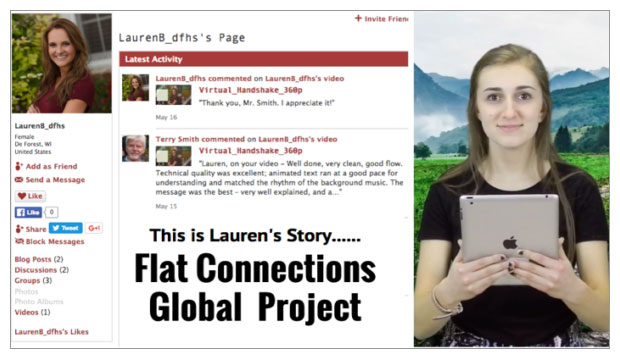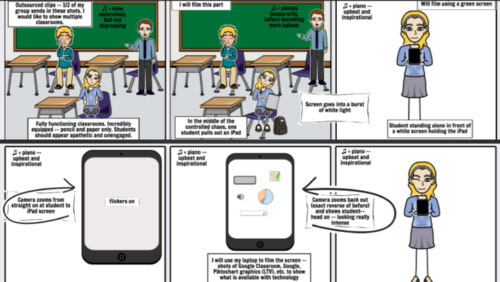
I often use the term ‘digital imperative’ to describe why and how learning needs to be digital, online and embrace both local as well as global learning modes. Digital fluency includes learning in both synchronous and asynchronous learning environments coupled with the ability to create and co create ideas, artefacts, solutions. The potential to use digital and online technologies to learn with the world and impact positively the lives of others is something we did not have when I went to high school….but we have it now, so let’s apply it!
Let’s look at an example. This is Lauren’s story…….
Lauren is a senior student at a high school in Wisconsin, USA. She came into the Flat Connections Global Project as a student leader. Her task was to coordinate a global team of about 10 students – encourage them to collaborate virtually on shared research objectives, and support them as they created their personal digital artefact to communicate an essential idea based on their topic. The project ran for about three months and culminated, as it has done many times in the past, in student summits and a final awards ceremony acknowledging student collaborative achievement.
This project is for high school students (age 13 and above) and therefore uses an open network to connect and communicate. Currently this network is the Flat Connections Ning. Students find their team members, share, discuss, upload images and media, send each other outsourced clips to satisfy artefact design, and use this network as the hub of learning. Yes, it is visible to the world – and what a great way for students to learn HOW to use ‘social media’ for learning.

Screenshot from the Flat Connections Ning
Lauren’s final digital artefact was about BYOD in education, and she co-created this with the help of others who sent requested out-sourced clips.
This is part of her storyboard as planning for the artefact.

Lauren’s Storyboard for Planning
This is Lauren’s carefully crafted final award winning video.
Yes! she won first place in the end of semester awards. Judged by an international group of educators.
So, what are the real benefits of joining an online global project and learning with others from different parts of the world?? Here are my ideas….what else can you add?
- Student autonomy – Development of responsible team work, leadership and independent learning modes
- Communication – Confidence connecting and communicating with others at a distance – knowing that this is becoming more common professionally for the future
- Global Citizenship – Understanding how to learn online, how to initiate ideas, what to share and how to respond to others across cultures
- Collaboration – Making online learning real! Working with others to build/create/develop something unique together
It’s time for education leaders, educators, parents and students to take ownership of digital learning, and not just ‘dabble on the edges’. It’s time to cut through some of the barriers preventing true global learning – technology access, curriculum constraints, fear of the unknown, lack of pedagogical knowledge – and realise that the world is flat and connected and how we learn is the same. It’s time to better understand and actually implement student self-determined learning that is connected and collaborative – as we say, students are the best text-book for each other – as shown by Sonya’s recent blog post, ‘Connections are the beginning of collaboration‘ about connected New Zealand with China – you are not going to get that experience from a textbook!
What are you waiting for?

Learners are the best textbook for each other

0 Comments